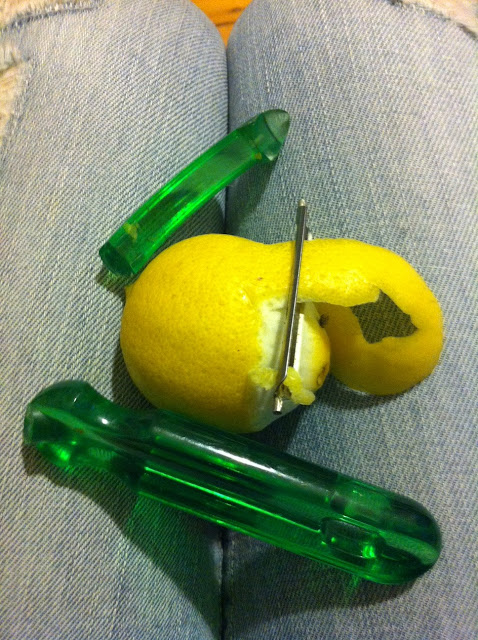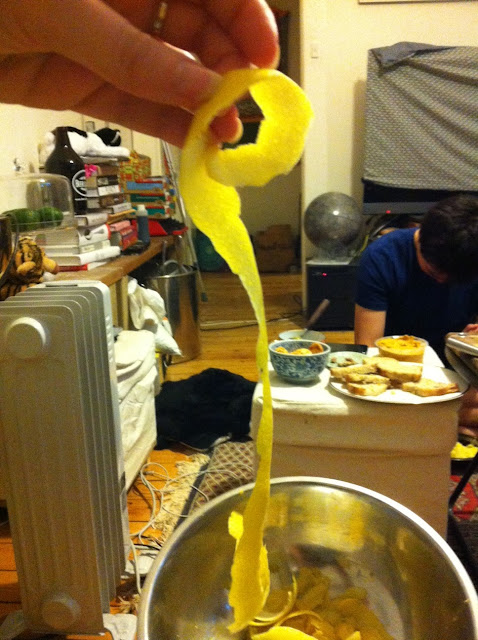
I was having dinner one night with some close friends who live across the road from us. I'd heard good things about Vacanza in the Hills Pizzeria in Surry Hills so we decided to check it out. The pizza was fantastic. Probably the best pizza I've had in Sydney (which I know is a big call, but having tried some of the other places in the area like Lucio Pizzeria and Pizza Mario, I think Vacanza takes the cake - or takes the nutella calzone and tiramisu desserts which were on the menu).
We had almost finished our pizzas when we realised that we hadn't received one of the other charcuterie dishes - a mortadella special.
 |
| The process killed one of our peelers... |
Sipping on the bright yellow liquer, my mate (who brews his own beer) raised the question of whether we could actually make our own limoncello. Coincidentally he and The Darling Baker had quite a few limes lying around that needed using, and we couldn't think of any reason why limes couldn't be added into the mix, so we decided to concoct a Lemon AND Lime-oncello as a bit of an experiment.
While you'd think the most important ingredient in limoncello is the citrus, I'd say the most important ingredient is actually the alcohol. The stronger the alcohol, the more of the lemon flavour and colour is extracted. Many American recipes ask for a spirit called Everclear, which is a grain alcohol that is close to 100% alcohol, but we couldn't find anywhere in Sydney that stocked it and we didn't want to go to the expense of shipping it out from the USA.
My mate did some research and found out that you could actually purchase a 95% grain alcohol from Dan Murphy's called Rectified Spirit. The stuff is actually from Poland, and is so potent that you have to ask for it at the counter because they keep it locked up in a cabinet. The bottle is labelled with the Polish words "SPIRYTUS RECTYFICOWANY" which made us slightly concerned about how strong it would be and whether it would taste any good. It comes in a small 500ml bottle with a price tag of $58.99, so we decided that it wasn't very cost effective for us to only use the rectified spirit to make the limoncello. Also, we thought it would be prudent to add some vodka into the mix too, as a way of possibly taking the harsh edge off the rectified spirit.
The process involves a fair bit of patience. It's time consuming grating or peeling off all of the rind from the fruit. We did this while watching the Eurovision song contest on SBS. I definitely think the cheesy songs, unnecessary fireworks, and over the top costumes/strange haircuts (see below) really enhanced the flavour of the limoncello in the end.
The other annoying part of making limoncello is that you have to wait three or four weeks until the alcohol has extracted all of the flavour from the rind.
So did the experiment pay off? Yes, most definitely - it was worth the effort and patience. The end result was really tasty and extremely lemony. I couldn't distinguish the lime flavour from the lemon, but I'd say you would be able to tell the difference if you compared our batch to one without limes. We filled some old bottles up with our concoction and now they're perched on my book shelf, ready for a quiet nightcap, or a lemon fuelled rampage.
Lemon & Lime-oncello
What you need
- 30 limes;
- 10 lemons;
- 500 ml of Rectified Spirit;
- 700 ml of good quality vodka;
- 1750 ml of sugar syrup made from 2/3 cup of sugar to every cup of water;
- Coffee filters.
What happens next:
- Before you can grate or peel off the lemon/lime rind, you need to remove any wax that would have been used to preserve the fruit. You can do this by dropping the fruit into boiling water for 30 seconds. When we tried it, we may have left our fruit in the boiling water for too long, as the fruit turned out a bit soft. This just makes it slightly more difficult to grate.
- Grate or peel off the rind from the lemons and limes, ensuring that you try to minimise the amount of the white pith which apparently makes the limoncello bitter. It's a good idea to use good quality peelers or graters - one of my flimsy peelers was completely annihilated in the process.
- Put all of the rind into a large jar that can hold 1200ml of alcohol. Then pour all of the rectified spirit and vodka over it. Note: Do this step away from open flames.
- Seal the jar up tightly and leave in a cool, dark place for 3-4 weeks, or until all of the yellow colour has come off the rind and the rind is pretty much white in colour.
- Then, four weeks later, brew up a sugar syrup, with two thirds of a cup of sugar to every cup of water. You need around 1750mls of sugar syrup to dilute the limoncello's alcohol percentage down to a palatable level of 25% alcohol. This is around 4 and two-thirds cups of sugar. You can dissolve the sugar into the water over the stove, but allow it to cool before adding it to the alcohol solution.
- You then need to strain the alcohol that has been soaking in the rind through the coffee filters. This takes quite a while, as you could imagine, and you need to keep changing the coffee filters regularly because, as we found out, they tend to break. But this removes all of the rind and stops it from being gritty or cloudy.
- Finally pour the sugar syrup into the alcohol and then pour the final limoncello mix carefully into bottles.
 |
| We drank the Limoncello from these snazzy port sippers. Apologies to the port drinkers. |
Note: Drink responsibly. Avoid heavy machinery. Jarhead does not condone the improper use of lemons and limes as described above.

















Whoah that's a lot of lemoncello. So awesome you made your own. And I love those port sippers!
ReplyDeleteI've always wanted to make limoncello because I love lemons! Sounds like it was definitely a success! :D
ReplyDelete